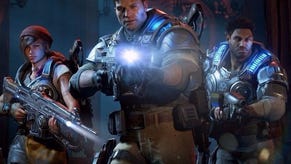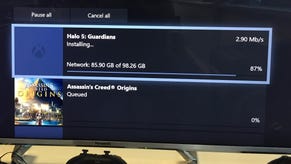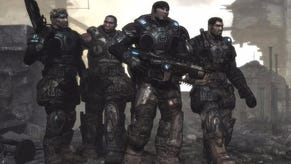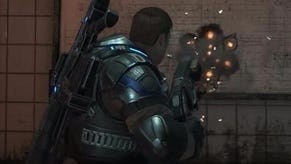Gears of War 4's campaign feels like an Epic revival
Hands on with campaign and multiplayer.
The views may be pleasantly apocalyptic, and the second act may feature a motorbike duel with a robot B52, but it's the little things that really sell me on Gears of War 4 - the surprisingly delicate way it both harkens back to and departs from Epic's original cover-shooters. The fact that Swarm footsoldiers rush you when they're close to death, for example, where their Locust predecessors would often dig in till the bitter end. The presence of branching path sections that ask teams of two to support one another across a gulf, a classic Gears device enlivened by the addition of flying enemies and eccentric new flavours of sniper rifle.
And then there's the Overkill shotgun, which perhaps encapsulates how well the Coalition understands the series it has inherited. On the surface it's a quad-barrelled monster worthy of Painkiller, but in practice the Overkill is a flexible instrument that, much like the famous Active Reload mechanic, challenges you to keep a cool head under pressure.
Simply pull the trigger and you'll fire all four barrels at once to shattering effect. But if you hold the trigger, pause and release, you'll fire each pair of barrels separately for a tighter spread, allowing you to dent targets at range and really make the most of your ammo. Shotguns have always been Gears of War's principal skill weapons, the roaring Sphinxes that gate access to the upper echelons of competitive multiplayer. With the Overkill, the Coalition has crafted both an elegant tool for returning Gnasher pros and a bloodthirsty treat for the rest of us.
Everywhere you look in Gears of War 4, you'll find a studio engaged in careful dialogue with the past. This is literally the case in the story, which takes place a few decades after the destruction of the Locust, and sees two generations of the Fenix clan fighting side by side. In a bid to shore up what remains of civilisation, the Coalition of Organised Governments has herded Sera's surviving humans into gigantic walled cities, defended by robots, but not everybody is content to trade their freedom for security. Amongst the rag-tag Outsiders who scrape a living in the wilderness is the one and only Marcus Fenix, he of the thousand yard scowl. As the game's second act begins, the COG is holding the Outsiders responsible for a spate of abductions, and new leading man JD Fenix has returned to his father's estate in hopes of guidance and a little covering fire, if not a hug.
What follows is essentially a license handover reimagined as a family squabble, a clash between epochs in video game characterisation. JD is a blond and blue-eyed graduate of Nathan Drake High, accompanied by glib sidekick Delmont Walker and token ladybro Kait Diaz, whose parents are among the missing. Marcus remains a potty-mouthed crank, cut from the rock of the WW2 shooter and pickled to perfection by years of isolation. The script isn't exactly captivating so far - in opting for a more presentable college age cast, the Coalition has sacrificed a certain vivacity - but the reinvention of Marcus as a grouchy hermit, bellowing about his greenhouse in the midst of a COG bombing run, is worth a few laughs. I'm looking forward to finding out who else is back from Gears 3. With any luck, the Cole Train still operates somewhere deep in the wilds.
The art direction is also something of a generational mash-up. The Coalition has come up with its own spin on the original's "destroyed beauty" aesthetic - "reclaimed beauty", an admittedly clunky buzzword which pays into an unexpected riff on fossil fuel politics. By the time of Gears 4, Sera's reserves of underground immulsion are long gone, Mother Nature has taken back much of the surface, and the population now depends on a hodgepodge of renewable energy resources.
The game's plunging rural fastness is littered with the vestiges of the old world and ramshackle stabs at revival - windmills idling against a baleful sunset, enormous flywheels canted against cliff-faces, hydroelectric dams torn open by the "windflares" that now rake the planet's crust. In the course of the campaign's five acts (an estimated 10 hours) you'll take a ride in a deteriorating funicular and do battle inside a memorial to the Pendulum Wars, Sera's darkest hour prior to the emergence of the Locust. A hint: some of the antique weapons on display are functional.
Inspired by the landscape of north Italy, the game's palette is quietly enchanting - wiry underbrush and purple leafpile, mildew-spotted signage and ground-down masonry, flowing together in a way that makes the cover layouts less obvious to the eye, if no less tangible under the thumb. Gears of War's world has always been uniquely textured, and the Coalition has done a fine job of weaving its own vision into the tapestry, aided no end by some fancy bells and whistles - screen-space reflections on puddles, physically based shaders for a more tactile look, and a persistent dynamic weather system which, at its most severe, actually affects how you play.
When the winds are raging, movement becomes a chore, certain terrain fixtures can be shot loose to create tumbling hazards, and slower projectiles such as the Boomshot's rounds may be blown off course, allowing you to sneak the odd shot around cover. If all this sounds transformative, however, the wind was seldom this much of a presence during my few hours with the campaign. For the most part, Gears of War 4's cover combat follows on from that of Gears 3, its AI behaviours, animations and even exploits painstakingly rebuilt to take advantage of Unreal Engine 4.
The basic rhythms are much as in any Gears game: you'll enter an area, slam your back against a pillar and work your way gradually around to flanking positions, overlooks and weapon drops, relying on AI comrades to revive you as and when you overreach yourself. The Coalition has added a few new tricks - you can reach across cover to haul a foe onto your combat knife, which adds an extra element of risk and reward to close-quarters gunplay - but any longtime Gears detractors hoping for a change of tune will come away disappointed.
There are, of course, new weapons to spice up the familiar double act of rifles versus shotguns. The Embar rifle handles like a mix of Torque Bow and Longshot - you must hold the trigger to charge up a slug, but if you hold it a second too long the weapon will vent, a blunder that's sure to rouse the scorn of Twitch chatboxes. The Buzzkill and Dropshot, meanwhile, are ways of cheating the game's cover logic. The former coughs up sawblades that ricochet around objects, while the latter spits out a flying drillhead that slams to earth explosively when you release the trigger.
More important than the new firearms, though, are the creatures you'll wield them against. Gears of War 4 introduces two new factions, the crusty Swarm and the COG's army of automatons or "Dee Bees". They share a number of familiar combat archetypes - units that pin you down, skirmishers that flush you out, and the odd towering bullet sponge equipped with a power weapon. But each faction boasts a few oddballs that may throw veteran players off-balance. The Dee Bees occasionally field Guardians, slippery UAVs that sport a chaingun or a rocket launcher (detachable, once you've shot the vehicle down) plus a recharging energy shield. Their rolling Tracker units are Kamikaze terrain denial weapons, exploding at your feet to create a brief but deadly puddle of static electricity.
The Swarm feel indistinguishable from the Locust at first, their rank and file emerging from sinkholes that can be sealed with a frag grenade, but just wait till you meet the Juvies - Swarm infants caught mid-gestation, fatty tissues dripping from their muscles as they hop and flail towards you. The original game's Wretches are the obvious comparison, but Juvies are much nimbler around objects and harder to hit - I was reminded a little of the Doom reboot's fidgety reinvention of the Imp, which is an encouraging parallel indeed. They also represent something of a terrain variable: you'll encounter Juvie egg sacks that can be used as cover, or shot down from the ceiling to squish anything beneath, but woe betide the player who rouses the occupant in the process.
Weirder and deadlier still are the Swarm elites, especially the prancing Snatchers - they'll actually ingest you if they get the chance, carrying the hapless victim around in their bellies till blasted into submission. Carriers are the Swarm's artillery, their enormous torsos cracking open to release a cloud of toxic spores as they stomp slowly into melee range, and then there are the Pouncers, catlike, dart-tossing fiends with soft pink bellies that hop from surface to surface. As the name implies, Pouncers may try to pin you, but if you're alert to the warning signs you can usually catch the descending beast on the blade of a Lancer.
Beyond the campaign, Gears 4 offers up a brace of familiar modes - Warzone, TDM, King of the Hill, and Guardian - plus the already discussed Dodgeball, a co-op bots mode and Arms Race, a team-based version of the Gun Game mod for Counter-Strike. In the latter, all team members get a different weapon after every third kill, which good news in that a struggling player won't be left behind, and less good news in that allies may accidentally sabotage each other. Finding that your Gnasher has become a Longshot after cornering an opponent is every bit as exhilarating as you'd imagine.
There's also Escalation, a three ring objective capture mode with a metagame element that is aimed squarely at the eSports community. The idea is to win seven rounds, the twist being that losing teams can activate a weapon spawn between rounds, whether to give themselves an edge or bait the other team into taking a risk. Backed up by LAN support and a robust suite of commentator options, it seems a good pitch for the tournament crowd.
But the star attraction in multiplayer is, of course, the new take on Horde, Gears of War's influential wave survival mode, which again follows on from Gears 3 but retains a few ideas from the underrated Gears of War: Judgment. The battle now revolves around a movable fabricator, where you'll construct fortifications such as turrets, fences and decoys using globs of power that must be manually collected from the bodies of the slain.
This creates more of a frantic, push-pull rhythm, as players scurry out to gather energy at the risk of being caught trousers-down when the next round begins. It accompanies a set of loose player classes - Heavy, Soldier, Engineer, Scout and Sniper - which determine your starting layout and are geared towards certain roles, but flexible enough that you can change tactics on the fly.
Each class has a selection of abilities, largely passive, that can be levelled up - the Scout can equip a skill that awards bonus Power when harvesting under fire, for instance, while the Soldier might plump for the ability to plant up to five grenade mines at once. The class system doesn't quite feel essential yet, and there's the suspicion that it exists to justify the sale of ability cards, though all abilities can be earned and upgraded in-game. But having to factor in the fabricator's location and resource gathering on top of the usual Horde strategies is a fun complication, and you needn't give those cards a second thought once you've left the lobby screen behind.
The truly disarming thing about Gears of War's return is that it no longer has an obvious rival. The original's mechanics have been imitated by every blockbuster under the sun, from Killzone through Tomb Raider to the Tom Clancy franchise, but most of its disciples have either died off or evolved beyond recognition. If the Coalition's debut is a fairly conservative work at heart, one that is content to tinker ingeniously within sturdy parameters, it nonetheless feels strangely exotic. There is no game out there right now that plays like this one, that uses quite these variables in quite this way, and while the revisions aren't mind-blowing individually, they're gripping as a whole. Marcus Fenix may have aged disgracefully, but Gears of War 4 has the wind in its sails.
This article is based on a press trip to The Coalition's headquarters. Microsoft paid for travel and accommodation.












